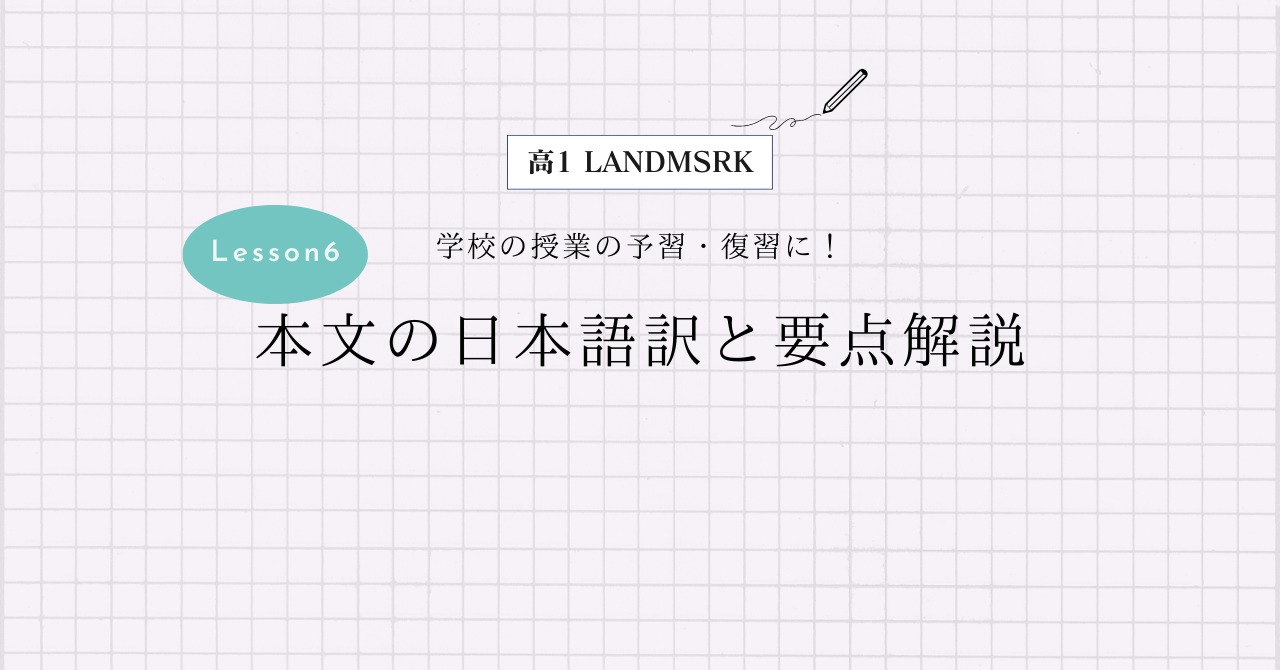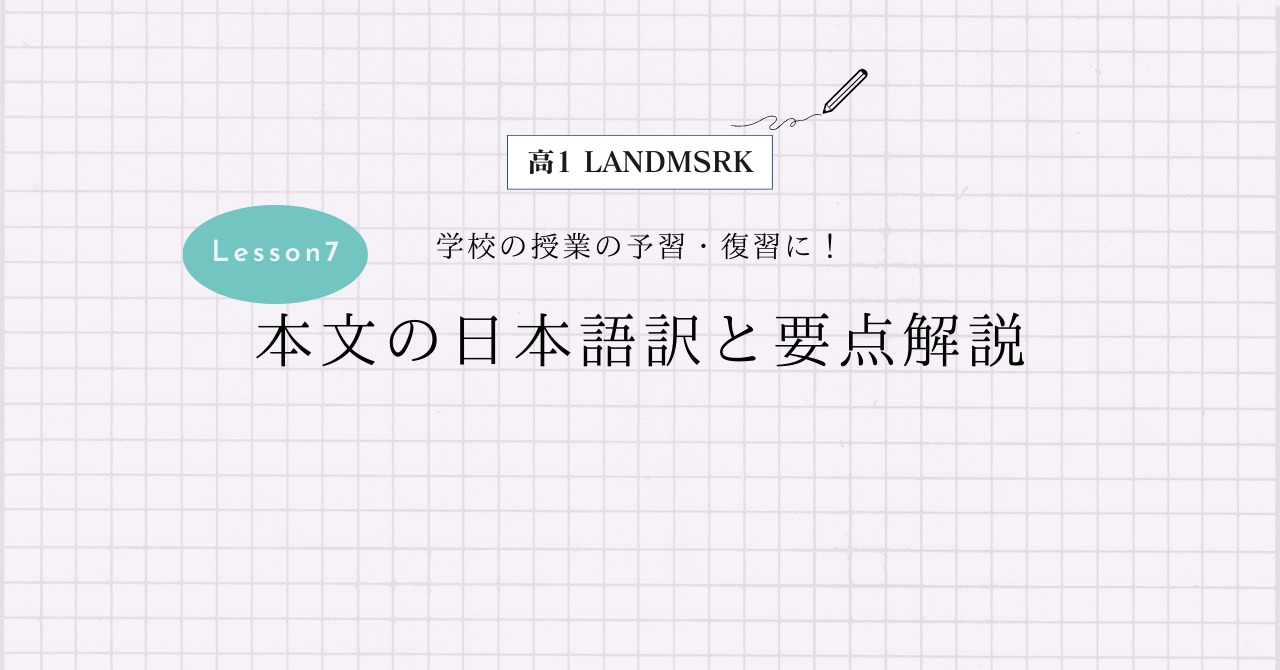啓林館 高1LANDMARK Lesson6 Part4の本文の日本語訳と重要箇所の解説です。
Lesson6-1, 6-2, 6-3の解説はこちらからご覧ください。
>高1LANDMARK Lesson6 Part1 本文和訳
>高1LANDMARK Lesson6 Part2 本文和訳
>高1LANDMARK Lesson6 Part3 本文和訳
- LANDMARK Lesson6 Part4 本文と日本語訳
- LANDMARK Lesson6 Part4 重要事項の解説
- You now know about differences in non-verbal communication.
- Let us consider how you can use non-verbal communication effectively.
- Some people use non-verbal communication consciously.
- In rakugo shows, for example, storytellers entertain their audience by telling stories using gestures and facial expressions.
- When they perform a character eating soba, they lift their folding fan up to their mouth and make a loud slurping sound.
- Such gestures help the audience understand the size, amount, or shape of an object, or the actions of characters.
- For example, they keep eye contact with the audience while they are speaking.
- They move their eyes from person to person, or group to group.
- By doing so, the listeners may pay more attention to what the speaker is saying.
- In many cases, non-verbal communication is unconscious.
- It can cause misunderstandings because the meanings differ from place to place.
- On the other hand, it can be an effective communication tool.
- If you are aware of the importance of non-verbal communication and can use it well, you will be able to convey your thoughts and feelings more effectively to many people.
- LANDMARK Lesson6 Part4 まとめ
LANDMARK Lesson6 Part4 本文と日本語訳
Q1. What do rakugo storytellers do to perform a character eating soba?
「落語家はそばを食べている登場人物を演じるために何をしますか?」
Q2. What kind of tool can non-verbal communication be?
「非言語的コミュニケーションはどんな種類のツールになりえますか?」
You now know about differences in non-verbal communication.
「あなたは今非言語的コミュニケーションの違いについて知りました。」
Let us consider how you can use non-verbal communication effectively.
「どのように非言語的コミュニケーションを効果的に使うことができるかを考えましょう。」
Some people use non-verbal communication consciously.
「非言語的コミュニケーションを意識的に使える人もいます。」
In rakugo shows, for example, storytellers entertain their audience by telling stories using gestures and facial expressions.
「例えば落語では,語り手はジェスチャーと表情を使いながら物語を話すことによって,観客を楽しませます。」
When they perform a character eating soba, they lift their folding fan up to their mouth and make a loud slurping sound.
「彼らがそばを食べている登場人物を演じるとき,折り畳んでいる扇子を口元に持ち上げ,大きなすする音を立てます。」
Such gestures help the audience understand the size, amount, or shape of an object, or the actions of characters.
「そのようなジェスチャーは,観客が大きさ,量や物の形,登場人物の行動を理解するのを助けます。」
Many good speakers use non-verbal communication in presentations.
「話すのが上手な人の多くはプレゼンテーションで非言語的コミュニケーションを使います。」
For example, they keep eye contact with the audience while they are speaking.
「例えば,彼らは話している間に聴衆とアイコンタクトをします。」
They move their eyes from person to person, or group to group.
「彼らは目を人から人へ,集団から集団へと動かします。」
By doing so, the listeners may pay more attention to what the speaker is saying.
「そうすることで,聞き手は話し手が言っていることにより注意を向けることでしょう。」
In many cases, non-verbal communication is unconscious.
「多くの場合,非言語的コミュニケーションは無意識です。」
It can cause misunderstandings because the meanings differ from place to place.
「場所によって意味が異なるので,非言語的コミュニケーションは誤解を引き起こすこともあります。」
On the other hand, it can be an effective communication tool.
「一方で,それは効果的なコミュニケーションツールにもなりえます。」
If you are aware of the importance of non-verbal communication and can use it well, you will be able to convey your thoughts and feelings more effectively to many people.
「もしあなたが非言語的コミュニケーションの重要性に気づき,それを上手に使うことができたら,あなたの考えや感情を多くの人により効果的に伝えることができるでしょう。」

LANDMARK Lesson6 Part4 重要事項の解説
You now know about differences in non-verbal communication.
“difference”は「違い」という名詞です。
“non-verbal”は「非言語」という意味で,“communication”は「コミュニケーション,意志疎通」という名詞ですね。
Let us consider how you can use non-verbal communication effectively.
“Let us 動詞の原形”は“Let’s~”を短縮せずに書いた形です。そのため「~しよう」という意味になります。
“consider”は「を考える,考慮する」という動詞で,“effectively”は「効果的に」という副詞です。
また,この文では「間接疑問文」が使われていますね。
Some people use non-verbal communication consciously.
“some”は「いくつかの」という形容詞ですが,「~な人もいる」くらいで訳せばOKです。
“consciously”は「意識的に」という副詞になります。
In rakugo shows, for example, storytellers entertain their audience by telling stories using gestures and facial expressions.
“for example”は「例えば」という重要表現ですね。
“storyteller”は「語り手」,“audience”は「観客,聴衆」,“gesture”は「ジェスチャー,身振り」,“facial expression”は「表情」という名詞になります。
“entertain”は「を楽しませる」という動詞ですね。
“using”は「~しながら」と訳す「分詞構文」になります。“using gestures and facial expressions”が“telling stories”を修飾する副詞の働きをしています。
“by”は「~によって」という「手段・方法」を表す前置詞です。他にも色々な意味があるので簡単にまとめておきます。
1.受動態とセットで「~によって」
2.”by+乗り物”で「交通手段」
3.「~までに」という期限
4.「~のそばに」という場所を表す
When they perform a character eating soba, they lift their folding fan up to their mouth and make a loud slurping sound.
この文では「接続詞when」も使われていますね。
“they”と“their”は“storytellers”を指しています。
“perform”は「を演じる」,“lift~up”は「~を持ち上げる」という動詞で,“character”は「性格,登場人物」,“fan”は「うちわ,扇子」,“mouth”は「口」という名詞になります。
“eating”は「現在分詞」で,“eating soba”が直前の“a character”を修飾しています。
“folding”は「折り畳んだ」,“loud”は「大きな」,“slurping”は「すすっている」という形容詞で,“sound”は「音」という名詞です。
Such gestures help the audience understand the size, amount, or shape of an object, or the actions of characters.
“such”は「そのような」という形容詞です。
“help 名詞 動詞の原形”は「名詞が~するのを助ける,手伝う」という重要表現ですね。
“understand”は「を理解する」という動詞で,“size”は「大きさ」,“amount”は「量」,“shape”は「形」,“object”は「物体」,“action”は「行動,活動」という名詞になります。
“of”は前置詞で,”A of B”の形で「BのA」というように後ろから前に訳します。
For example, they keep eye contact with the audience while they are speaking.
“they”は“Many good speakers”を指しています。
“keep”は「を保つ」という動詞ですが,今回は「アイコンタクトをする」と訳しています。
“while”は「~の間」という接続詞になります。
They move their eyes from person to person, or group to group.
“They”と“their”は“Many good speakers”を指しています。
“move”は「を動かす」という動詞で,“from A to B”は「AからBまで」という表現ですね。
“group to group”の前には,その前で出てきた“from”が省略されています。
By doing so, the listeners may pay more attention to what the speaker is saying.
“doing”は「代動詞」で,前置詞“by”の後ろなので「動名詞」になっていますね。
“doing so”は直前の「人から人,または集団から集団へと目を動かすこと」を指しています。
“may”は「~かもしれない」という推量の助動詞になります。
“pay attention to~”は「~に注意を払う」という重要表現で,“more”は“much(たくさんの)”の「比較級」ですね。
“what”は「関係代名詞」で,“the thing(s) that 主語 動詞”の意味になり,「主語が~すること」となります。
つまり“what the speaker is saying”で「話し手が言っていること」という意味ですね。
In many cases, non-verbal communication is unconscious.
“case”は「場合,状況」という名詞で,“unconscious”は「無意識な」という形容詞です。
It can cause misunderstandings because the meanings differ from place to place.
“It”は“non-verbal communication”を指しています。
“cause”は「を引き起こす」,“differ”は「異なる」という動詞です。
“misunderstanding”は「誤解」,“meaning”は「意味」という名詞になります。
“from place to place”は「場所によって」という表現です。
On the other hand, it can be an effective communication tool.
“on the other hand”は「一方で」という重要表現です。
“it”は“non-verbal communication”を指しています。
“effective”は「効果的な」という形容詞で,“tool”は「ツール,道具」という名詞になります。
If you are aware of the importance of non-verbal communication and can use it well, you will be able to convey your thoughts and feelings more effectively to many people.
この文では「接続詞if」が使われていますね。
“be aware of~”は「~に気づく」という重要表現で,“importance”は「重要性」という名詞,“well”は「上手に,よく」という副詞です。
“it”は“non-verbal communication”を指しています。
“be able to 動詞の原形”は「~することができる」という,助動詞“can”と同じ重要表現ですね。
“convey”は「を伝える」という動詞で,“thought”は「考え」,“feeling”は「感情」という名詞になります。
“more effectively”は「比較級」になっていますね。
LANDMARK Lesson6 Part4 まとめ
以上がLANDMARK Lesson6 Part4の日本語訳となります。
「関係代名詞what」「分詞構文」などの使い方をしっかり確認しておきましょう!
>高1LANDMARK Lesson6 Part1 本文和訳
>高1LANDMARK Lesson6 Part2 本文和訳
>高1LANDMARK Lesson6 Part3 本文和訳
何か分からない点や他に解説してほしい点があれば,お気軽にコメントしてください!




コメント